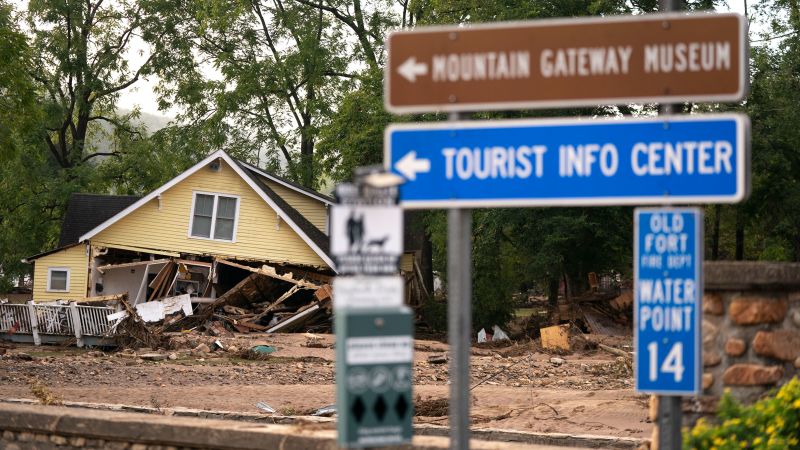CNN
—
With the full extent of the devastation and loss of life still coming into view, tourism officials in states along Helene’s destructive path are offering nuanced guidance about which parts of their states are accessible to visitors.
It’s a balancing act for officials, who are weighing the economic effects on communities less heavily impacted by the storm against the long recovery many people in their states now face.
In Western North Carolina, Eastern Tennessee and other mountainous areas in Helene’s path, the storm arrived just as the fall foliage season was set to bring throngs of tourists into towns and rural areas.
Numerous national and state park sites along the path remain closed, while some counties and towns are getting power and communications back online.
Asheville and nearly all of the surrounding communities in Western North Carolina are currently off-limits.
“State and local officials strongly advise all motorists avoid travel in Western North Carolina due to the continued challenges and risks from riverine flooding, landslides, slope failures, road closures and downed trees,” a Western North Carolina travel advisory says, adding that power and communications outages and shortages of water, food and gasoline are still widespread.

But there are some limited exceptions, even in hard-hit North Carolina, according to tourism officials.
The travel advisory, posted on the Visit North Carolina website, notes that while most of Western North Carolina should be avoided, there are areas in the far western part of the state that are “ready and welcoming visitors.”
Those include the counties of Cherokee (Murphy area), Clay (Hayesville area), Graham (Robbinsville area), Macon (Franklin and Highlands area) and Swain (Bryson City area), according to an October 3 advisory update.
“Visitors should call ahead to confirm their plans and ensure safe routes for travel to access these mountain destinations,” the post said.
DriveNC.gov lists current road conditions. The advisory also lists information related to which state welcome centers are closed and ways to help and donate to the recovery effort.
The balance of sustaining communities economically while allowing space for recovery is not lost on many would-be visitors, who have peppered Facebook posts with queries about whether proceeding with fall trips would help or hurt.
In a comment on the Visit Highlands NC Facebook page, one prospective visitor said, “We just want to do what is best for the Highlands community, and appreciate your candid thoughts.”
The Facebook account for a local boutique responded, “We welcome you with open arms!”
Another local Facebook user offered an extended answer about locals’ “mixed” feelings. “So it depends … What are your specific plans?” the poster asked, noting that visiting downtown shops and restaurants would be OK, but driving all over the region would be hazardous and “annoy the Be-Jesus out of utility workers” and some locals coping with the storm’s effects.
Highlands dodged many of the most severe effects of the storm, and the head of the Highlands Chamber of Commerce and Visit Highlands said in an online update that “we can consider ourselves fortunate.” The majority of businesses, stores and restaurants in the town are open, according to a Thursday afternoon update.
In Tennessee, the state’s Department of Tourist Development posted an update on its website, noting that “much of Tennessee is open for business.” The post said that the popular tourist towns of Gatlinburg, Pigeon Forge and Sevierville were included in that assessment.
“Travel with caution and call before you go,” the post advised.
Parts of Great Smoky Mountains National Park, the country’s most visited national park, are open, but outdoor recreation in the park is discouraged because of limited staffing and visitor safety concerns. Several roads in the park – situated in Western North Carolina and Eastern Tennessee – are closed, the National Park Service said Monday.
“While we recognize that this is a popular time to visit the park, visitors are encouraged to reschedule their trips for their own safety,” NPS said, noting in a Monday Facebook post that destinations in Sevier County are “fully open to those who can access the county through safe routes.”

Another popular NPS site, the Blue Ridge Parkway, is closed along its full length in North Carolina and Virginia.
As of Thursday afternoon, the travel alerts section of Explore Georgia’s website did not offer location-specific guidance for travel within the state.
Discover South Carolina’s travel advisory notes several welcome center closures because of power outages and state park closures.
Visit Florida’s page dedicated to Helene resources points visitors to attractions, state park closures and Florida 511 pages for travel information.
Virginia tourism officials have urged caution when traveling in impacted areas of Southwest Virginia.
“While travel in some Southwest Virginia destinations is challenging at this time, some counties and cities in the region are open and ready to welcome visitors,” Virginia Tourism Corporation posted on its website
“Resident and visitor safety is our top priority, and the Virginia Department of Emergency Management and the Virginia Department of Transportation are monitoring conditions as response efforts are underway,” VTC said.
Travelers should confirm plans to make sure destinations are able to receive visitors. The VTC notice also pointed to select state park closures, relief and recovery efforts and other travel information.
